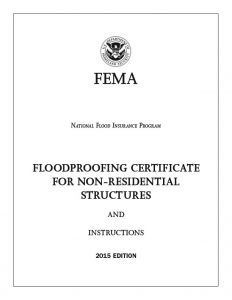Blog
Media Contact
Email: media@floodpanel.com
Updated FEMA Floodproofing Design Certificate Required for Non-Residential Structures
The National Flood Insurance Program (NFIP) permits floodproofing of non-residential buildings instead of elevating to or above the Base Flood Elevation (BFE). For these structures, a floodproofing design certificate is required.
Take a look at the revised floodproofing certificate here.
According to the Federal Emergency Management Agency (FEMA) NFIP Floodproofing Certificate for Non-Residential Structures and Instructions, 2015 Edition:
“A floodproofed building is a building that has been designed and constructed to be watertight (substantially impermeable to floodwaters) below the BFE and with structural components having the capability of resisting hydrostatic and hydrodynamic loads and effects of buoyancy. Before a floodproofed building is designed, numerous planning considerations, including flood warning time, uses of the building, mode of entry to and exit from the building and the site in general, floodwater velocities, flood depths, debris impact potential, and flood frequency, must be addressed to ensure that dry floodproofing will be a viable floodplain management measure.

The minimum NFIP requirement is to floodproof a building to the BFE. However, when it is rated for flood insurance one-foot is subtracted from the floodproofed elevation. Therefore, a building has to be floodproofed to one foot above the BFE to receive the same favorable flood insurance rates as a building elevated to the BFE.
Additional guidance can be found in FEMA Publication 936, Floodproofing Non-Residential Buildings (2013), available on FEMA’s website at https://www.fema.gov/media-library/assets/documents/34270.”

